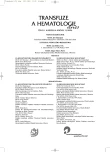Real cost of chronic myeloid leukemia treatment with nonmyeloablative hematopoietic stem cell transplantation and comparison with cost of hypothetical imatinib treatment. What shall be considered in the cases of extremely costly medical procedures?
Authors:
J. Mayer; Y. Brychtová; M. Doubek; M. Krejčí; J. Vorlíček
Authors‘ workplace:
Interní hematoonkologická klinika FN Brno - Bohunice
Published in:
Transfuze Hematol. dnes,12, 2006, No. 1, p. 6-13.
Category:
Comprehensive Reports, Original Papers, Case Reports
Overview
In chronic myeloid leukemia (CML), allogeneic hematopoietic stem cell transplantation is still considered as the only curative procedure. However, older reports unanimously showed the high frequency of transplant-related complications and deaths. In recent years, 2 new treatments emerged: nonmyeloablative hematopoietic stem cell transplantation and imatinib. The first one is a modification of well-known transplant principles with intention to lower their side effects. Imatinib, a completely new drug, has been discovered by harnessing the newest knowledge of CML molecular pathogenesis. However, imatinib is not able to satisfactorily eradicate all malignant cells. Both treatments options, albeit very different concerning the mechanism of action and side effects, have actually one common feature – high cost. In this work, the real transplant cost (1st chronic phase CML, conditioning with busulfan + fludarabine + ATG) was compared with hypothetical imatinib treatment (400 mg/day) in the same patients; the lengths of imatinib treatment corresponded to the follow-ups upon the transplantation (3-82 months). Two transplanted patients died from intractable GvHD. The total cost of transplantation treatment of all patients is 45 991 020 Kč (median: 2 197 948 Kč; mean: 2 299 551 Kč). The main cost burdens were hospitalizations, laboratory examinations, and outpatient drug treatment. The total cost of hypothetical imatinib treatment would be 58 629 488 Kč (median: 2 235 844 Kč; mean 2 931 474 Kč). The main cost burden was imatinib itself. Imatinib treatment would be especially high in patients who would have longer follow-up. It seems that transplantation treatment starts to be less expensive than imatinib after 2 years of follow-up. This work cannot answer the complex question of indication of either treatment option. It showed, however, that treatment cost is a very important parameter in the decision algorithm. The authors mean that in newly diagnosed 1st chronic phase CML patients with an HLA-identical family donor, the hematopoietic stem cell transplantation with a nonmyeloablative conditioning (busulfan + fludarabine + ATG) is still a very valid option.
Key words:
imatinib, chronic myeloid leukemia, bone marrow/peripheral blood stem cell transplantation, pharmacoeconomics
Labels
Haematology Internal medicine Clinical oncologyArticle was published in
Transfusion and Haematology Today

2006 Issue 1
Most read in this issue
- Real cost of chronic myeloid leukemia treatment with nonmyeloablative hematopoietic stem cell transplantation and comparison with cost of hypothetical imatinib treatment. What shall be considered in the cases of extremely costly medical procedures?
- Transmission of prion disease by blood and hot news in detection methods of abnormal prion protein
- Immunophenotyping of childhood leukaemias
- The use of alemtuzumab in allogeneic stem cell transplantation
